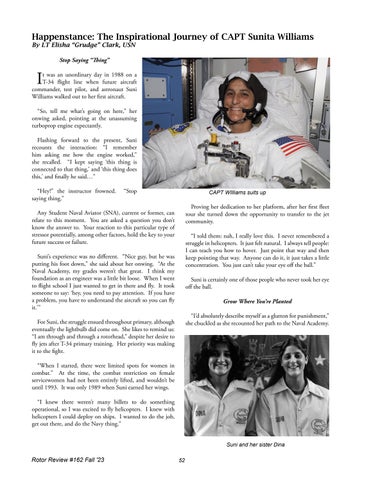Happenstance: The Inspirational Journey of CAPT Sunita Williams By LT Elisha “Grudge” Clark, USN Stop Saying “Thing”
I
t was an unordinary day in 1988 on a T-34 flight line when future aircraft commander, test pilot, and astronaut Suni Williams walked out to her first aircraft. “So, tell me what’s going on here,” her onwing asked, pointing at the unassuming turboprop engine expectantly. Flashing forward to the present, Suni recounts the interaction: “I remember him asking me how the engine worked,” she recalled. “I kept saying ‘this thing is connected to that thing,’ and ‘this thing does this,’ and finally he said…” “Hey!” the instructor frowned. saying thing.”
“Stop
CAPT WIlliams suits up
Proving her dedication to her platform, after her first fleet tour she turned down the opportunity to transfer to the jet community.
Any Student Naval Aviator (SNA), current or former, can relate to this moment. You are asked a question you don’t know the answer to. Your reaction to this particular type of stressor potentially, among other factors, hold the key to your future success or failure.
“I told them: nah, I really love this. I never remembered a struggle in helicopters. It just felt natural. I always tell people: I can teach you how to hover. Just point that way and then keep pointing that way. Anyone can do it, it just takes a little concentration. You just can’t take your eye off the ball.”
Suni’s experience was no different. “Nice guy, but he was putting his foot down,” she said about her onwing. “At the Naval Academy, my grades weren’t that great. I think my foundation as an engineer was a little bit loose. When I went to flight school I just wanted to get in there and fly. It took someone to say: ‘hey, you need to pay attention. If you have a problem, you have to understand the aircraft so you can fly it.’”
Suni is certainly one of those people who never took her eye off the ball. Grow Where You’re Planted “I’d absolutely describe myself as a glutton for punishment,” she chuckled as she recounted her path to the Naval Academy.
For Suni, the struggle ensued throughout primary, although eventually the lightbulb did come on. She likes to remind us: “I am through and through a rotorhead,” despite her desire to fly jets after T-34 primary training. Her priority was making it to the fight. “When I started, there were limited spots for women in combat.” At the time, the combat restriction on female servicewomen had not been entirely lifted, and wouldn’t be until 1993. It was only 1989 when Suni earned her wings. “I knew there weren’t many billets to do something operational, so I was excited to fly helicopters. I knew with helicopters I could deploy on ships. I wanted to do the job, get out there, and do the Navy thing.”
Suni and her sister Dina
Rotor Review #162 Fall '23
52














































